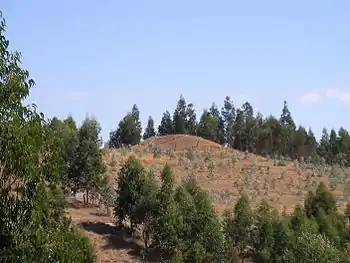Cuel
The cuel are Mapuche-built tumulus. The best known cuels are near the localities of Purén and Lumaco in Araucanía, south-central Chile. The first significant studies of the cuel were published by Tom Dillehay and José Saavedra in 2003 and 2007.[1][2] The word cuel is a neologism formed from the mapudungun word kuel, meaning boundary marker (Spanish: lindero) according to the 18th century dictionary of Andrés Febrés.[3]

A cuel in the valley of Purén amidst an Eucalyptus plantation (38°4′34.80″S 72°53′13″W).
References
- Dillehay, Tom. (2007). Monuments, empires and resistance. Cambridge University Press. 504 p.
- Dillehay, Tom D.; Saavedra Z., José (2003). "Interacción Humana y Ambiente: el desarrollo de Kuel en Puren-Lumanco (Region de la Araucania)" (PDF). Revista Austral de Ciencias Sociales (in Spanish) (7).
- Febrés, Andrés (1765). Arte de la lengua general del Reyno de Chile (in Spanish). Lima. p. 463.
This article is issued from Wikipedia. The text is licensed under Creative Commons - Attribution - Sharealike. Additional terms may apply for the media files.